Any building looks complete when all the finishing work is completed. The pick-up for the pile foundation performs many functions on which the comfort in the house depends. The element is made from various materials. Self-arrangement requires adherence to simple rules.
Definition and purpose of pickup
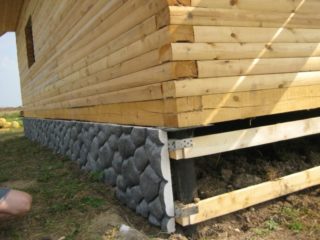
A glossary of architectural terms describes a pick-up as a partition of planks that fill the space between the beams.
In houses on pile foundations, the lower floor - the floor of the first floor - is above the ground surface. The space must be protected. To do this, equip a pick-up, where the bars are the base columns.
Zabirka is a type of base and performs similar functions:
- Protection of the space under the ground floor overlap from rain and snow - moisture contributes to the formation of mold and mildew. In the cold season, with sharp jumps in temperature, any building material, including concrete, is intensively destroyed. Wet soil is more prone to heaving, which can affect the reliability of the building structure.
- Reduced heat loss through the bottom floor. According to research data, up to 25% of the heat can go through the floor into the ground. This percentage is higher when erecting houses on columnar foundations.
- Preventing debris, animals and birds, weeds from entering the house.
The plinth gives attractiveness and completeness to the entire structure - a house on stilts does not correspond to the cultural traditions of our country, does not create an impression of reliability.
Based on the requirements, the intake must be solid, resistant to any climatic phenomena and have a minimum thermal conductivity.
False base materials
The building material for picking up the pile foundation is selected based on local operating conditions, the presence and design features of the grillage.
Concrete plates
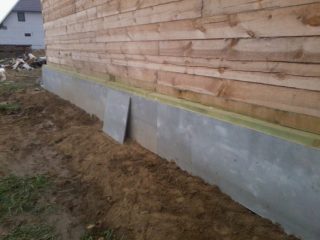
Concrete products are more often used when arranging the pile foundation of industrial buildings, where there are no high requirements for the appearance of the building. In private houses, concrete is "ennobled" by finishing with various materials, which increases the final cost of the entire construction.
The slabs must be at least 100 mm thick in order to protect the underfloor space from the cold.
There are two mounting technologies:
- The slabs are supported or suspended from the foundation pillars. This makes the mass of the building heavier and must be taken into account when designing the pile field. It will be necessary to protect the space from the lower edge of the slab to the surface of the earth from the penetration of water and animals.
- For installation, a strip reinforced foundation is made so that the slabs do not warp. For the foundation, they dig a trench 50 cm deep, make a cushion of rubble and sand, lay an armopoyas and pour a layer of concrete.
To protect against moisture, waterproofing is carried out with coating or roll materials.
After installing the plates around the entire perimeter of the house, the blind area is poured.
Ceramic brick
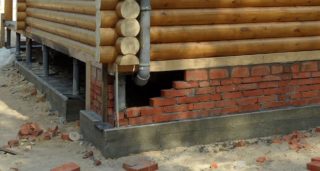
The technology is similar to the arrangement of a pick-up from concrete slabs.
Between the piles, a foundation strip is arranged, on which a brick is laid. The thickness of the wall is chosen at least 25 cm - laying "in brick".This will provide mechanical strength, wall stability and protect the house from frost.
For work, only ceramic clay (red) brick is used - white (silicate) brick will collapse within 2-3 seasons of house operation.
Finishing is carried out with plaster, artificial stone, siding. Penoplex is used for insulation - extruded polystyrene, which is also plastered and subsequently painted.
On a screw foundation, posts are brought out with bricks around metal piles, which protects them from rapid wear under the influence of climatic conditions.
Cement particle boards
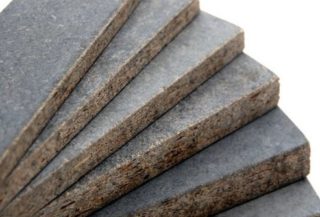
CBPB sheets are made from Portland cement, wood chips and additives, including calcium chloride, aluminum sulfate, aluminum sulfate, aluminum chloride, sodium silicates.
Cement is a binder, filler shavings. The additives prevent rotting, mold formation, and repel moisture. The material is non-flammable and durable.
Thermal conductivity is low, which reduces energy consumption for heating.
For the manufacture of the pick-up, a crate is mounted, which is rigidly attached to the piles.
DSP sheets are attached to the crate with self-tapping screws. The final finishing is carried out with plaster or sheet materials such as "siding". To fit the required dimensions, the sheets are cut with a hand saw on wood or with an electric tool.
If necessary, the slab filling is made two-layer, and the gap is filled with heat-insulating material.
Flat slate
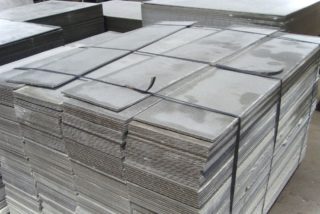
The material is characterized by an increased service life; sheet sizes are standardized.
It is important to take into account that slate is a fragile material and is not used in places where mechanical stress is possible.
An angle grinder with a stone wheel is used for cutting.
For installation, metal corners are mounted, to which the slate is screwed or a lining is welded.
Basement siding
On sale there is a siding made of metal, fiber cement, aluminum or plastic.
Components that prevent the negative influence of climatic factors, including light-stabilizing additives, are added to the composition of siding for outdoor use. Such material does not fade in the sun and does not lose its properties.
The panels are attached to the lathing, the logs of which are installed in increments recommended by the manufacturer.
Thermal panels
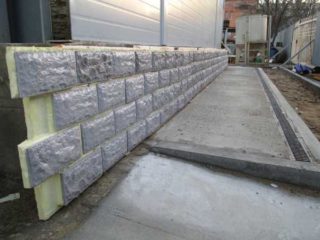
Products are produced from various materials and different textures - wood, steel, stone. They are united by their design. An external layer that is resistant to mechanical stress is factory-glued to a sheet of heat insulator (polystyrene, penoplex).
The material is produced in the form of panels with large geometric dimensions or in the form of tiles.
There are two types of installation:
- gluing to a pre-fabricated wall;
- fastening to anchors, screws, bolts.
The advantage of such materials: resistance to climatic conditions, improved quality of thermal insulation.
The high price tag limits its ubiquitous use.
Installation of plinths from boards
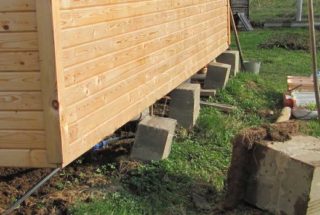
The simplest, sometimes temporary option for arranging the basement part is picking up from the boards.
The construction of the finishing material must have a tongue-and-groove structure. A board with even edges will necessarily decrease in size when it dries, gaps appear between adjacent parts. Through them, moisture, harmful microorganisms, rodents and insects penetrate into the subfloor.
The pick-up from sheet piling boards can be made from the following types of products:
- Batten. Has a thorn-groove connection, which eliminates the formation of cracks. For the outer part, they do not use pine, which quickly deteriorates, and oak, which cracks along the entire length of the board. In terms of price-quality ratio, choose a floorboard made of larch.
- The lining is similar in structure to a floorboard, but the assembled pick-up has a textured appearance after the parts are connected. They choose lining with a thickness of at least 25 mm, but such products are sold at a high price.
- Block house - a version of the lining that has the appearance of a rounded log. Products are produced from solid boards or glued from separate pieces. If painting is supposed, then it is preferable to buy a glued version, it shrinks less.
- Edged board is the least suitable for picking device due to drying out.
A new-fashioned material - composite decking - accurately imitates real wood, is resistant to any atmospheric phenomena, and is varied in texture and color. The tongue on the edges prevents the formation of gaps and holds the parts together securely.
High price hinders distribution.
Mounting method
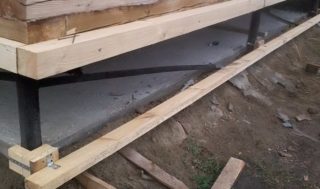
Planks in a wooden fence are placed horizontally, vertically, or at an angle to the ground - it all depends on the project and the combination of finishing the basement and walls.
The sequence of arranging a pick-up with your own hands:
- Lumber is harvested, the boards are dried under a canopy for at least a month, protecting them from sunlight.
- The building material is impregnated with an antiseptic composition and fire retardants - substances that prevent combustion. Color if necessary.
- They dig a trench along the perimeter of the foundation to a depth of 50 cm and a width of 20-30 cm.
- Gravel mixed with sand is poured into the bottom of the recess, the mixture is rammed. Backfill height 10-15 cm.
- A crate is prepared from a bar of 50x50 mm or thicker, depending on the mass and size of the grooved board.
- Adjust the size and attach the pick-up boards to the lattice.
- The joints are covered with wooden overlays.
- The remaining place in the trench is filled with expanded clay.
- Arrange a blind area around the building.
At the stage of marking, they provide places for entering communications into the house, as well as two ventilation ducts on each side of the house.
Frequent construction mistakes
When arranging a pick-up, technology violations can be made, which lead to difficulties in construction and a reduction in the service life of the base:
- Work is carried out until the final shrinkage of the building, which can take 5-6 months.
- Use a building material untreated from decay and fire.
- They make a large step of the lathing, which affects the strength of the structure.
- When making the base, they do not provide for the entry point for communication; they do this already at the stage of sheathing, which delays the work.
- Do not leave a gap between the hanging fence and the blind area.
- The layout of the adjacent territory is sloping towards the house, which contributes to the flow of water to the walls of the building.
The pile foundation must be equipped with a false plinth. The works are not very difficult even for a novice master. A simple power tool is enough to build. The result of finishing work will be noticeable in the first year of operation of the house.








